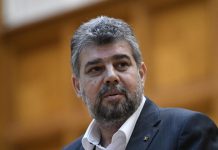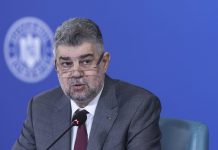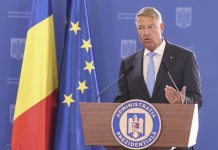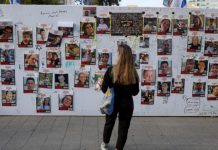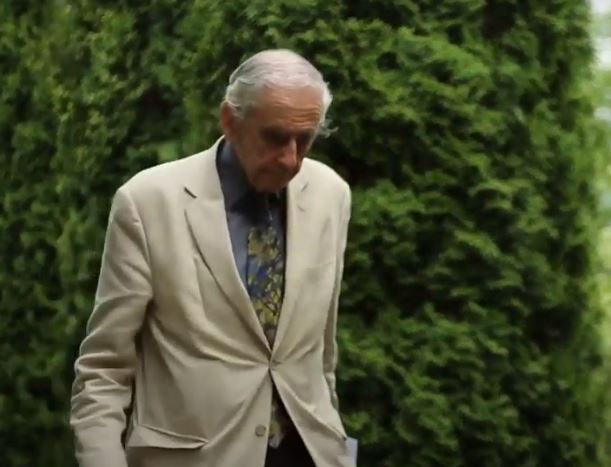In 2018, Nicolae Ratiu gave a speech at the Romanian Cultural Institute ICR in London about protecting Romania’s national heritage, describing what a handful of patriotic Romanians had done in recent years to restore the iconic Voronet monastery and Banffy castle among others.
He then passionately related the David and Goliath story of Rosia Montana gold mine and a gold mining company „founded by two shady and corrupt characters who over 20 plus years bought the support of dozens of Romanian politicians, paid off every political party and poured millions annually into the media.”
Public opinion
Opposing this behemoth was just two non-governmental organizations and growing public opinion.
But sometimes things don’t go the way you expect in Romania. Public opinion grew into „a national awakening, a significant cleansing of corruption, and, some would say, a genuine people-led revolution,” Mr.Ratiu said. The gold mine project never went ahead.
The unsung hero of this incredible saga which dominated headlines, created tensions and bitterly divided Rosia Montana for many years was Serban Cantacuzino, a Romanian architect and member of the Cantacuzino princely family, Mr.Ratiu said at a commemoration of his life in June.
Mr. Cantacuzino died at the age of 90, a few months earlier.Now as the Romanian government faces a fine of US$2 billion from an arbitration case brought by Gabriel Resources, we remember the story and details that have never been published before.
„It’s the story of a true patriot from a historic aristocracy who nevertheless wanted nothing for himself from Romania but was only interested in what he could give to Romania,” he told Universul.net.
Mr. Ratiu is the younger son of presidential candidate, philanthropist and businessman, Ion Ratiu affectionately known as ‘Mr Papilon” as he often wore a bow tie.
Cyanide
To remind people about the story, Rosia Montana was a joint venture to develop Europe’s largest open-cast gold/silver mine. Strong local opposition emerged in 2000 when Rosia Montana Gold Corporation (RMGC), the joint venture between Gabriel Resources (80%) and the Romanian state (20%), announced its intentions to destroy much of the historic village of Rosia Montana, resettle the local population and use large quantities of cyanide to separate the ore from the gold.
Resistance
Resistance spread across the country with many associating the venture with corruption; including at the highest political level.
PRO PATRIMONO is the Romanian National Trust.
This is Mr.Ratiu’s speech.
„Serban Cantacuzino had from the early ‘90s envisaged the establishment of an organisation in Romania to protect and restore the nation’s neglected and crumbling heritage. Regularly during those ‘90s, Serban led tours of friends and interested parties to visit many of the treasures of that heritage. 1998/9 my brother Indrei returned from the United States with a similar dream. Something had to be done. Indrei and I called together a ‘steering committee’ at the London offices of the Ratiu Foundation. The steering committee included additionally Jessica Douglas Home, William Blacker, John Nandris, Serban’s sister Marie-Lyse and Inga Haag and we talked – for a long time…. Then Marie-Lyse organized a dinner – all met with Serban – showed slides of Voroneti – raised some money amongst us and friends. Serban went to Brasov, gave a lecture to a group of 25 young architects. Silvia Demeter (mother) registered Pro Patrimonio in Romania. First registered in Brasov, then later transferred to Bucharest. Serban from his wide circle of Romanian friends, acquaintances and admirers, Silvia Demeter, of Brasov. with prestigious Board members including Andrei Pippidi, Matei Likyardopol, Prof Aurelian Triscu, Hermann Fabini, Alexandra Beldiman, Serban Sturdza, Ion Caramitru, Dinu Giurescu, Lois de Menil and others. The Bucharest registered Foundation was launched with the help of Marina Sturdza in the Hall of Mirrors in the Royal Palace under the Royal Patronage of King Michael of Romania.
Pro Patrimonio
We had all agreed to form a Romanian National Trust initially named Pro Patrimonium – until I believe Nandris pointing out the incorrect Latin declination, whereupon Pro Patrimonio – The Romanian Heritage Foundation was formed, with Serban himself organizing the drafting of the English mission statement, statutes, inviting the first trustees Robert Chorley, Michael Thomas, Indrei and Nicolae Ratiu, Moritz Fried joining the initial Board and registering Pro Patrimonio as a UK charity (2001).
The first achievements of Pro Patrimonio were the restoration of the wall paintings at the Voronet monastery organized exclusively by Serban even before an executive team was put together. The next three projects were the acquisition and restoration of a Saxon village house at Viscri, a landscaping study and proposal for the grounds of Banffy Palace at Bonsida, and the Golescu Villa.
Further details of our ongoing projects you can learn from our leaflets downstairs to which please help yourself. With the kind permission and encouragement of Serban’s family and the Romanian Cultural Institute, in Serban’s memory and his legacy you have the opportunity to both donate to Pro Patrimonio, or become a member on the spot or even both.
Inspiration
Serban was not only our inspiration, leader, but also our tireless fundraiser. Those who participated will never forget the tours he led to the painted monasteries of Moldavia, or his lectures on them around the UK, or the Music and Art fairs held here at the Cultural Institute, and the major events we held at the Royal Geographic Society where Serban memorably publicly challenged the then chief executive of the Rosia Montana Goldfields Corporation to justify their intended destruction of the ancient Roman mine workings at Rosia Montana in the Apuseni mountains of Transylvania.
Serban had the charming trait of always assuming the best in people – a trait from which I’m sure we all benefited – but it could also get him into trouble. It did once with a cynical lawyer who convinced him to sell for a fraction of their real value some of the family’s forests and land assets. Fortunately he told me, I was able to intervene and what would have been yet another cruel exploitation of his family by the communists and now neo-communists had a much happier ending.
Cyanide-laced dust soup
Something similar occurred during the 20 year struggle to block the RM Goldmine project, a project to dynamite and crush into a cyanide-laced dust soup the entire historic area. For those not aware, to put the story in context, RMGC was founded by two shady and corrupt characters who over 20 plus years bought the support of dozens of Romanian politicians, paid off every political party and poured millions annually into the media_ against which there were 2 rather small NGOs, Alburnus Major and Pro Patrimonio – and a growing public support.
In 2010 a certain Csilla Hegedus, President of the Transylvania Trust, and counselor to Kelemen Hunor, the then Minister of Culture, approached Serban with an appeal to fund an archaeological heritage study on the area, prepared by an eminent group of British specialists in Roman history and archaeology – its purpose being, according to Hegedus, to cause Rosia Montana to be designated a UNESCO heritage site, thereby protecting it forever, with the study to be delivered to the Archaeological Commission of the Min of Culture, for presentation at a Europa Nostra meeting in Brussels at which Serban would participate. Serban agreed and raised €10,000 from Pro Patrimonio members. When time came to pay, he and I both requested that Pro Partimonio see the content of the report. This produced near hysteria from Hegedus accusing Serban of introducing unacceptable new conditions, breach of their agreement etc. Honorable as ever Serban gave in to her demands. The Europa Nostra meeting occurred but no study was presented.
Dirty money
To our astonishment, two months later, in Spring 2011 we hear of an ‘Agreement’ reached between RMGC and the Romanian Ministry of Culture guaranteeing a €50 million heritage investment plus further €50m environmental guarantees all to be paid by RMGC on condition that a Discharge Certificate be issued by M of Environment thereby permitting the destruction of 90% of all the Roman mines at Rosia Montana. It was a dirty deal with dirty money going to members of the government. The Report had simply been used to increase the sum of money payable by RMGC for the deal they had already struck. The report should have rendered a discharge certificate impossible. Coincidentally, perhaps, the Transilvania Trust Banffy palace acquired a new roof….
We took the Ministry of Culture to court demanding sight of the report. The Ministry’s ase was that the Report did not exist. There being no record of it being paid for by the Ministry of Culture – therefore, the report ‘did not exist’ – -and Pro Patrimonio’s case was premature and unfounded. (this was the reason Csilla Hegedus needed Pro Patrimonioto pay for the report directly – leaving no trace). Bizarrely the Ministry of Culture however had to admit that receipts for expenses approved by Minister Kelemen Hunor himself, existed, covering the displacement of Ministry of Culture personnel to accompany 3 British experts to Rosia Montana. This Kafka-esque approval of expenses for a non-existent report was conveniently ignored by the judge.
Which ‘report’?
Pro Patrimonio had also opened legal proceedings in the UK against the heritage specialists demanding to see the report that PP had undeniably paid for. Despite their confidentiality agreement with Ministry of Culture, they were on the point of releasing the report to us but informed CH of their intentions. Again a hysterical Hegedus threatened them with legal action for breach of their confidentiality agreement and Serban and myself with libel. Again: which ‘report’ – and what was to be kept confidential?
Under English law in an action both parties have to disclose to the other side all relevant files. Inevitably we would get access to the report’s content. So, suddenly in October 2013, Kelemen Hunor, no longer Minister of Culture, and probably tipped off to this imminent disclosure, released the report himself. All hell broke loose in the press and on the streets of Romania. The now published report categorically declared the unique status of the whole Rosia Montana area, a historic and archaeological ensemble of world significance, in all required respects worthy of World Heritage protected status.
Colectiv fire
The public’s revulsion at the Romanian Government’s duplicitous involvement in hiding the report and the clearly dirty hidden dealings with the Rosia Montana Gold Corporation fired a massive nationwide and international protest, blocking the project. This in turn mobilized the public against corruption in general, upending Victor Ponta’s presidential ambitions, electing President Iohannis, and ultimately, following the Colectiv fire tragedy, bringing down Ponta’s government.
I tell you this story because it was really Serban’s original course of action, with that same trait of always assuming the best in people- agreeing to fund the ‘non-existent’ report, that ultimately led to national awakening, a significant cleansing
of corruption, and, some would say, a genuine people-led revolution.
I thank the family and you for the opportunity of being able to speak about Serban and tell you this story.
And, please do not forget to assist us in Pro Patrimonio continuing battle to preserve and restore Romania’s extraordinary heritage which was so important to Serban…there are still many mountains to preserve …. and to climb.
Pro Patrimonio website address is www.propatrimonio.org
Donations toPro Patrimonio to continue its work are very much needed and would be very much welcomed.






